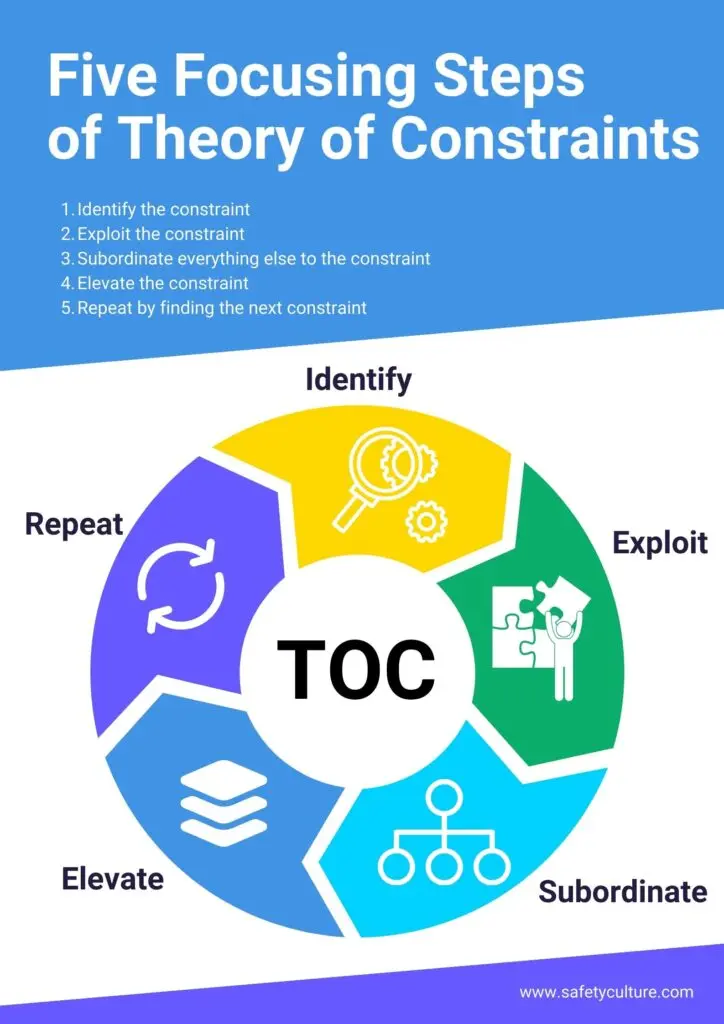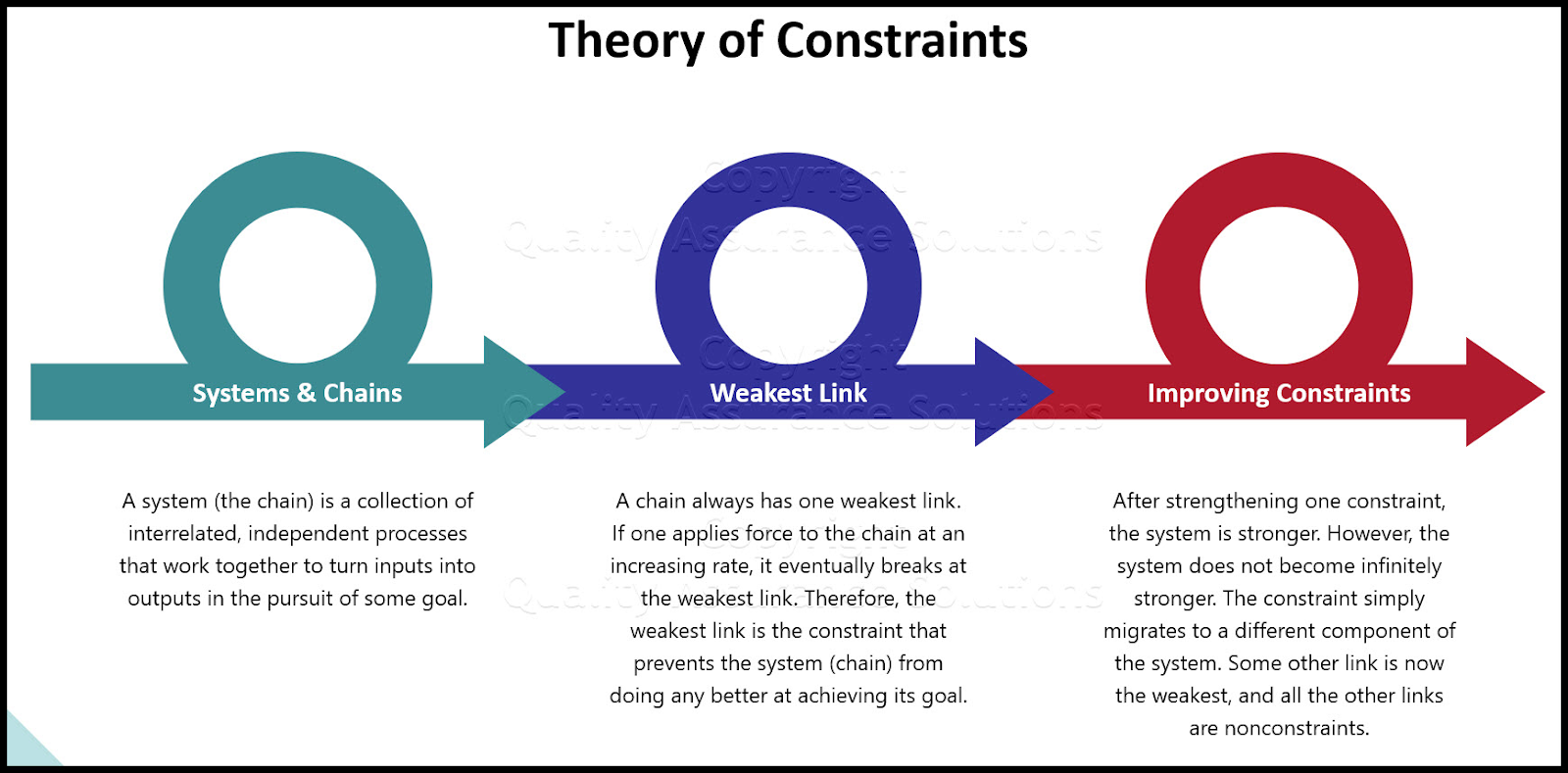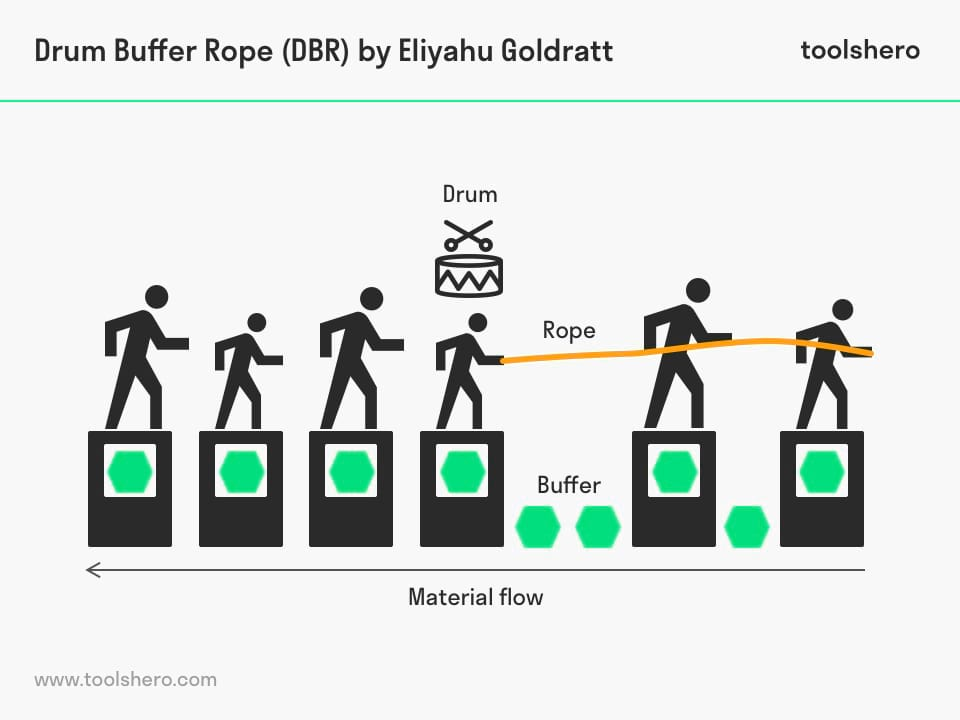Theory of Constraints (TOC) is a system-based philosophy that focuses on the limiting factor that slows the face of performance of a process. It is, therefore, suggesting that by identifying the constraint and managing the improvement of that constraint an organization can continuously improve its overall system. In this light, it becomes critical to understand concepts such as throughput, inventory, and operational expense in grasping the very dynamic theory. Tools applied as levers to the theory include Drum Buffer Rope and Thinking Processes which assists in managing the constraints of the system. The tools can help in properly ensuring the coordination of chain reactions in the course of events in a project process. It uses buffers for safety and assures a smooth improvement of the process.
Introduction to the theory of constraints
TOC is a system-based philosophy applied in helping organizations to identify their greatest limiting factor or constraint that lies between them and their goals. It can, because of that, help in continuous improvement because it helps uncover and manage the system or organizational constraints that retard continued improvement. The theory's tools such as the Drum Buffer Rope and the Thinking Processes focus on the chain of events in any project process while focusing on throughput, inventory, and operational expense in maintaining the buffers deemed essential. Ultimately, the Theory of Constraints focuses the improvement of the process towards the most constraining factors that determine the success of the system.
Definition and basic principles
Theory of constraints is a system-based philosophy directed at discovering what can be referred to as the most critical limiting factor that stands in the way of ultimately realizing and achieving one's goal and systematically improving that constraint until it stops being the limiting constraint. It is developed by Dr. Eliyahu Goldratt as principles such as throughput, inventory, and operational expense. Some of the tools that the theory of constraints uses include Drum Buffer Rope, a scheduling methodology, and Thinking Processes, a set of tools to address organizational constraints. Throughput accounting mainly focuses on continuous process improvement, and an organization uses buffers and analysis of the chain of events to guide their project process and break down the system's constraints.
History and development of the theory
The theory of constraints is a system-based philosophy introduced by Dr. Eliyahu Goldratt in the 1980s. Its primary focus tries to identify the limiting factors or system's constraints that an organization has that prevent it from attaining its objectives. The primary objective of this theory is to ensure that there is continuous improvement by managing these constraints. The theory mainly gets used in project process management that utilizes strategic tools such as drum buffer rope and the thinking processes. These tools guide the chain of events in operation with the main aim of reducing operational expense, managing throughput, and maintaining streamlined inventory. Buffers are used in this kind of a theory mainly to cater to variation in the process. This project process improvement methodology has become a significant part of organizational development and has nevertheless supported the identification and management of organizational constraints.
Understanding the five focusing steps of the theory of constraints

The Theory of Constraints is a system-based philosophy that focuses on achieving continuous improvement by the identification and addressing of a system's constraints. This innovative management approach involves five focusing steps: identifying the limiting factor (the constraint), deciding how to exploit it, subordinating all other processes to it, elevating it, and going back to step one and keep repeating the process. The key to this theory is throughput, inventory, and operational expense, which most of the time present as organizational constraints. Critical tools in this approach include Drum buffer rope, Thinking Processes, and Buffer Management, which together streamlines the project process and facilitates effective process improvement.
Identify the constraint
The theory of what they call the theory of constraint is hinged upon the system-based philosophy, in which the concept is based on identifying the single largest limiting factor within any system. With the identification of the said constraint, it gets improved through the system until it is no longer the limiting factor. With this type of identification and the continuous improvement of the system's constraints, then organizational operational expenses can be reduced by a great margin and improvement in the throughput identified. Utilization of scheduling based on Drum-buffer-rope and thinking processes can demonstrate how the chain of events in a project process is affected by constraints. The concept that builds on the idea of buffers that provide a safeguard against the unavailability of resources. Continuous process improvement will be an initiative as part of the constraints meeting. More focus on inventory management will help to identify factors that may limit the smooth running of operations.
Exploit the constraint
The theory of constraints is a very imperative system-based philosophy that is only based on identifying and managing the constraints within a system. Constraints may entail the limiting factor, organizational constraints, amount of inventory, or even the chain of events that is within a project process. The project process and the chain of events play a great role in the aspect of the identification and the alleviation of the constraints. Then, the theory also provides tools like Drum buffer rope and thinking processes, which assist in process improvement. Both tools support continuous improvement—a major aspect of the theory. They accentuate focus on throughput, operation expense, and inventory; hence, they facilitate sound decisions. Examples of solutions devised include constraints, for example, the use of buffers, and others which can address the constraints efficiently in this approach. It also enhances continuous system improvement by exploiting the constraint in order to yield the maximum overall process.
Subordinate everything else to the constraint
The Theory of Constraints (TOC) is like the Sherlock Holmes of project management. It’s all about spotting that elusive limiting factor—the constraint—that’s playing hide-and-seek with your goals. Picture this: every system has at least one constraint, or else it would be belting out infinite output like a caffeinated espresso machine. But here’s the twist: when you’re on a quest for improvement, don’t waste your energy fixing what’s already doing the job.
So, how do you tackle this beast? You’ve got to play favorites. All those other resources in your system? They’re like supporting actors in a blockbuster movie. Their job? Bow down to the constraint. Seriously, they’re the backup dancers, and the constraint is the diva center stage. Without addressing that star player, your overall throughput—the money-making engine—won’t budge. So, step one: find the constraint. Step two: give it a makeover.
Now, let’s talk about rhythm. DBR is your dance partner. It’s all about keeping the beat synchronized. The ‘drum’ sets the tempo—it’s your constraint, remember? And those buffers? They’re like bodyguards, shielding your project from chaos. Variability? No problem. Smooth chain of events? Check. Inventory management? Nailed it. Operational expenses? Tamed. DBR is the choreography that keeps your project tango flawless.
Elevate the constraint
The theory of constraints isn’t just theory; it’s action. Imagine you’re climbing a mountain. The constraint? That steep peak. Your mission? Elevate it. This isn’t a leisurely stroll; it’s a strategic ascent. And guess what? Tools like Drum buffer rope are your trusty crampons. Buffers? They’re your safety harness, preventing slips and slides. Combine that with Thinking Processes—the Sherpas guiding your way—and suddenly, that peak doesn’t seem so daunting.
Prevent iInertia from becoming the constraint
Inertia—the silent assassin. It creeps into organizations, wraps its tentacles around progress, and whispers, “Stay comfy, my friend.” But we’re not having it. Enter the theory of constraints, our superhero cape. It swoops in, identifies those sneaky constraints, and says, “Not today!” With techniques like Drum buffer rope, inertia doesn’t stand a chance. It’s like a wake-up call for the whole team: “Time to break free!” So, keep that chain of events flowing, and watch inertia slink away.
Benefits of applying the theory of constraints
The Theory of Constraints is a system-based philosophy that offers multiple benefits to businesses. It identifies the limiting factor or constraints within the system that hinder a business operation from achieving its maximum potential. This focus helps management concentrate on significant areas rather than non-critical operations.
Improved decision making
The Theory of Constraints addresses the increase of throughput, reduction of inventory, and handling of operational expenses. By identifying and managing constraints within the system, it facilitates continuous improvement within an organization. Tools like Drum Buffer Rope and Thinking Processes help manage organizational constraints and buffers, promoting a strategic approach to decision-making. This leads to improved outcomes and efficiency.
Increased efficiency and productivity
Applying the Theory of Constraints can dramatically increase efficiency and productivity within an organization. It identifies and addresses the constraining factor, often termed 'constraints' of the system, to enhance throughput. This approach empowers businesses to maximize profits while minimizing operational expenses. Continuous process improvement and effective inventory management are achieved using tools like Drum Buffer Rope and understanding the chain of events.
Enhanced profitability
The Theory of Constraints assists in determining a company's limiting factor, also known as the system's constraint. This system-based approach focuses on continuous improvement with the goal of increasing throughput, reducing operational expenses, and lowering inventory to enhance profitability. Key strategies include using Drum Buffer Rope for planning, balancing resource priorities around constraints, and embedding buffers to anticipate variability and protect system performance. These strategies contribute to improved project processes, eradication of organizational constraints, and overall process improvement.
Real-world applications of the theory of constraints

The theory of constraints is a systems philosophy that is used all over the world in almost every type of industry to attain continuous improvement and process improvement objectives. By identifying and resolving constraints in a system, a company is able to achieve maximized throughput while simultaneously minimizing inventory and operating expenses.
This theory finds application in manufacturing where the bottleneck or the limiting factor in a production process is identified and optimum efficiency in respect of that factor is elicited. One of the most important applications is in supply chain management whereby buffering of the constraints in the chain of events ensures smooth flow of products. In implementing the Thinking Processes and Drum-buffer-rope concept of Theory of Constraints, the principles are logically used to sequence the activities properly and effectively manage the organizational constraints in project management.
Application in manufacturing
The theory of constraints, based along with its applications like drum buffer rope and thinking processes, is one of the critical constituents in manufacturing. They provide a systematic-based philosophy to intentionally unearth and handle those constraints of the system where a limited throughput is realized and, for that matter, allow for operational expenses to be raised in an indirect manner. These possible limiting factors could be expressed at whatever point in the manufacturing chain of events and may bring about some crippling bottlenecks within the production process.
Such organizational constraints are best done away with for the sake of continuous process improvements. It suggests the required buffer between the stages and thus reveals the weakest links of the process. Besides, it also works toward driving the management of inventory to maximum efficiency. All these put together could make organizations produce and profit.
Application in project management
The theory of constraints in project management applies a system-based philosophy that focuses on identifying and addressing the limiting factor(s) within an operation to effect process improvement. This approach often requires managing organizational constraints that tend to hamper project success and raise operational expenses. The focus is on the system's constraints, or bottlenecks, and utilizes methods like Drum buffer rope to schedule activities and protect the project process from these constraints.
Key elements of the practice include:
- Throughput: the rate at which a system generates money
- Inventory: all the capital tied up in the system
- Operational expense: all the money spent to turn inventory into throughput.
The ultimate goal is to promote continuous improvement and increase overall project efficiency.
Application in supply chain management
Supply Chain Management significantly benefits from the application of the theory of constraints, a system-based philosophy that emphasizes focusing on the limiting factor (the system's constraints) that hinders the chain of events leading to goal completion. These constraints could be organizational constraints or issues inflating operational expenses.
Drum buffer rope and buffers are useful for maintaining throughput and controlling inventory. The methodology promotes continuous improvement, which is a crucial element needed in process improvement within the project process.
Moreover, thinking processes are applied to understanding and dealing with these system constraints, ultimately leading to greater efficiency and effectiveness in the supply chain.
Challenges in implementing the theory of constraints
Implementing the Theory of Constraints (TOC) often poses significant challenges. One of the main issues arises from the system-based philosophy of TOC which requires an across-the-board understanding and application - a shift that many organizations find hard to make. On a related note, identifying the actual system's constraints can also be difficult. This is because the limiting factor that constrains the throughput may not always be apparent and might be embedded deep within the project process or the chain of events.
Furthermore, the TOC approach of reducing operational expenses and inventory, while striving for continuous improvement, often clashes with traditional management customs. Specifically, the shift from being efficiency-oriented to becoming throughput-oriented might require a significant cultural change. Plus, incorporating buffers and using the Drum Buffer Rope technique requires a new set of thinking processes that some teams could struggle to adopt.
Resistance to change
Resistance to change is a significant limiting factor in implementing a system-based philosophy such as the theory of constraints. This theory identifies and addresses a project process's organizational constraints, thereby enabling process improvement and continuous improvement.
However, challenges could arise in integrating the new approach with existing operations, resulting in increased operational expense, adjustment in throughput and inventory management, and reorganization of the chain of events. Therefore, strategies like Drum buffer rope and buffers should be put in place to facilitate this transition.
Identifying the true constraint
The theory of constraints is a system-based philosophy that targets the limiting factor (constraint) hindering a system from achieving higher performance. This theory maps out a chain of events leading to the problem to identify the constraint. It views a business as a chain of linked processes; thus, the weakest process (the system's constraint) limits the whole system's throughput.
To ensure continuous improvement, this approach monitors this constraint and finds ways to loosen or remove it, reducing operational expense and excess inventory. Key tools used in this approach are buffers, Thinking Processes, and the Drum buffer rope method, all focused on process improvement and better project processes.
Tools and software for implementing the theory of constraints
Thinking Processes, a system-based philosophy, plays a crucial role in identifying and managing organizational constraints. It’s like the detective work of project management, helping you uncover those hidden bottlenecks. With Thinking Processes, you’re not just scratching the surface; you’re diving deep into the murky waters of process improvement.
Drum Buffer Rope

Ah, the rhythmic beat of the drum! Drum Buffer Rope is your operational maestro. It orchestrates throughput management while keeping operational expenses in check. Think of it as the conductor waving the baton, ensuring that the project symphony stays on tempo. And those buffers? They’re like safety nets, catching any unexpected curveballs and maintaining the harmony.
Goldratt's Scheduling Software - S-DBR
Goldratt’s S-DBR scheduling software is the James Bond of TOC tools. It’s sleek, efficient, and licensed to kill… inefficiencies. Armed with the drum buffer rope approach, it takes on system constraints head-on. The ‘drum’ sets the pace, and the buffers handle the twists and turns. It’s like a high-stakes poker game where the stakes are operational excellence.
Harmony decision maker by Goldratt Research Labs
Harmony Decision Maker isn’t just a tool; it’s a mindset. Rooted in the theory of constraints, it’s like having a wise sage whispering in your ear during tough decisions. By streamlining throughput and managing inventory, it’s your secret weapon against operational expenses. And those complex problems? Harmony Decision Maker untangles them using the Thinking Processes playbook.
Conclusion: Maximizing potential with the theory of constraints
The Theory of Constraints isn’t just theory; it’s action. It’s about spotting the bottleneck, rolling up your sleeves, and saying, “Not today!” By wielding tools like Drum Buffer Rope and Thinking Processes, you’re not just breaking down barriers; you’re building bridges to success. So go forth, my constraint-busting warriors, and unlock your organization’s full potential.






